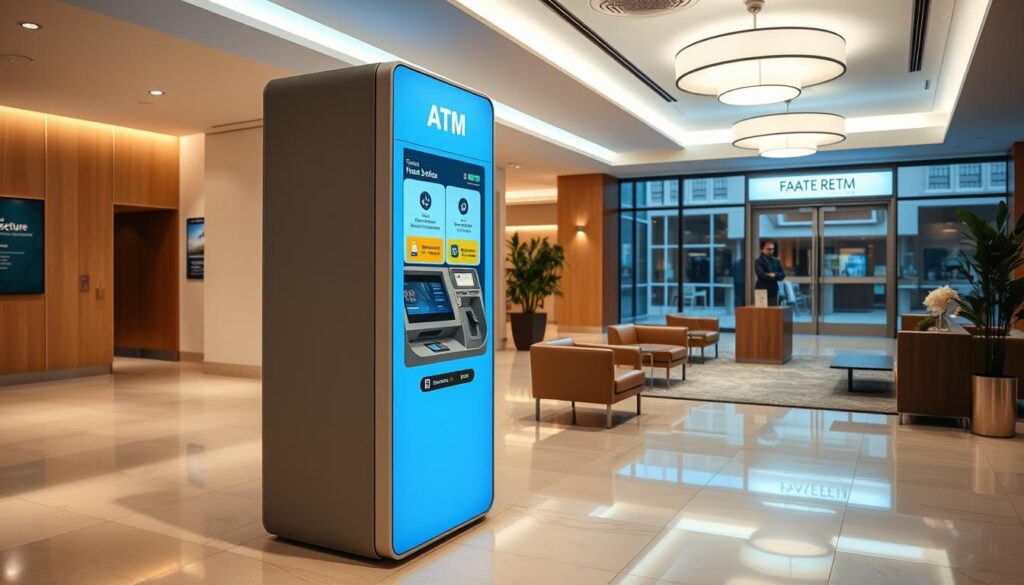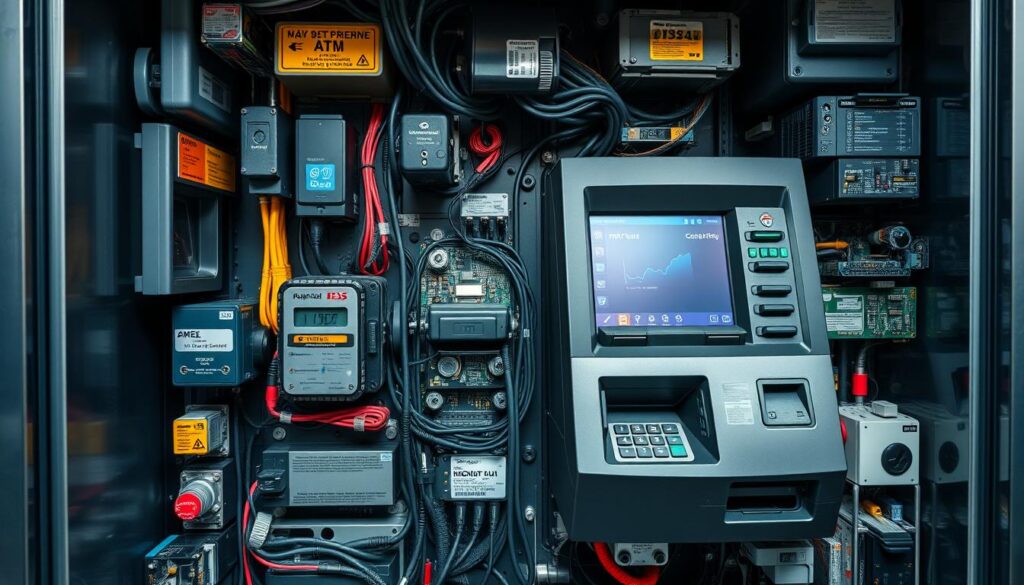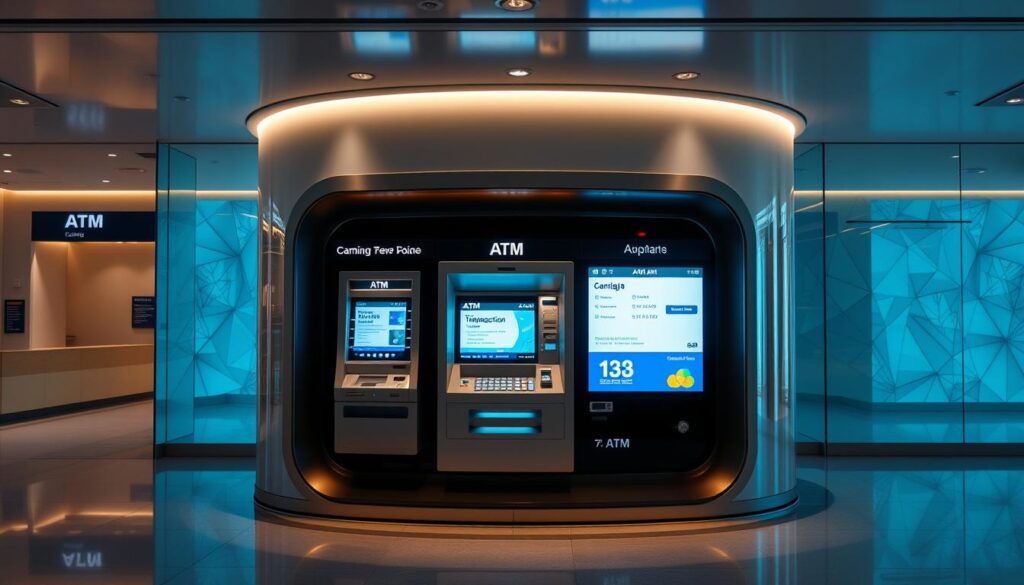The banking world is changing fast, thanks to self-service kiosks. These machines, like ATMs, do more than just give out cash. They can handle deposits, payments, and many other financial tasks. ATMs have been around for decades, starting in the 1960s.
Today’s banking self service kiosks use the latest tech. They’re open 24/7, making banking quicker and cheaper for banks. Customers get more control over their money, enjoying privacy and ease. Whether it’s withdrawing cash or paying bills, these kiosks are key in banking, meeting many customer needs.

Key Takeaways
- Self-service kiosks for banks offer a wide range of banking services, including deposits, cash withdrawals, transfers, and bill payments.
- ATM kiosks provide 24-hour accessibility, boosting user convenience and satisfaction.
- Specialized banking kiosks cater to diverse customer needs, from cash dispensers to full-service solutions.
- Secure features like card readers, keypads, and transaction monitoring ensure the safety of customer transactions.
- Innovative technologies in banking kiosks, such as cash recycling and cloud integration, are transforming the industry.
Understanding Self-Service Banking Kiosks: Evolution and Importance
The banking world has changed a lot, moving from old-fashioned teller services to new digital options. Self-service banking kiosks are now key in this change. They let customers do more than just take out cash.
From Traditional Banking to Digital Solutions
Self-service kiosks have grown because people want easy, quick banking. They want to manage their money without hassle. These kiosks offer a simple way to do many banking tasks.
The Rise of Automated Banking Services
More banks are using self-service kiosks to save money and give customers access any time. These banking technology tools make things like depositing checks and paying bills easier. They help reduce the need for human tellers.
Key Components of Modern Banking Kiosks
Today’s banking kiosks are packed with advanced tech. They have card readers, cash machines, touchscreens, and secure connections. All these work together to make banking easy and safe for customers.
| Key Component | Function |
|---|---|
| Card Readers | Make it easy to use debit/credit cards for safe transactions. |
| Cash Dispensers | Let customers get cash, a main feature of these kiosks. |
| Touchscreens | Make it easy for customers to use the kiosk for their banking needs. |
| Secure Connectivity | Keep the kiosk safe and connected to the bank’s systems for quick transactions. |
The growth of self-service kiosks comes from customer needs for easy banking. Banks also save money and offer services anytime. As banking moves online, these tools will be even more important.
Essential Hardware Components and Security Features
Modern banking kiosks, also known as ATMs, have key hardware parts for safe transactions. Card readers capture payment info, and cash dispensers make withdrawals easy. These parts are vital for self-service banking.
Advanced security is also key to protect financial data and bank assets. ATMs have physical safes for cash and webcams to watch user activity. Biometric scanners, like fingerprint readers, add an extra layer of security to ensure only the right people can use the ATM.
Digital Protection Measures
Digital security is just as important as physical security in modern ATMs. Strong encryption keeps customer data safe, and secure networks block unauthorized access. Specialized software watches transactions and alerts for any odd activity.
These security steps together make banking safe and reliable for customers. They build trust in ATM technology and banking security in today’s digital banking world.

“The security of our customers’ financial information is our top priority. We have invested heavily in cutting-edge security features to protect against cyber threats and physical attacks.” – John Smith, Chief Information Security Officer, XYZ Bank
Types of Self Servicing Banking Kiosk Services and Transactions
Banking kiosks, also known as ATMs or self-service terminals, offer many services. They let customers withdraw cash, deposit money, check balances, transfer funds, and pay bills. Some kiosks even help open accounts, update information, and print statements.
Some kiosks have a cool feature called cash recycling. It lets deposited cash go to other customers. This cuts down on the need for banks to constantly refill cash machines, saving money.
Full-service ATM kiosks do almost everything a bank teller can. But simpler cash machines just let you withdraw cash and check balances. This variety makes it easy for customers to handle their banking needs on their own.
| Kiosk Services | Functionality |
|---|---|
| Cash Withdrawals | Allows customers to withdraw cash in various denominations |
| Cash and Check Deposits | Enables customers to deposit cash and checks into their accounts |
| Balance Inquiries | Provides customers with real-time account balance information |
| Fund Transfers | Facilitates the transfer of funds between accounts |
| Bill Payments | Allows customers to pay their bills through the kiosk |
| Account Opening | Enables customers to open new bank accounts at the kiosk |
| Information Updates | Allows customers to update their personal and account information |
| Statement Generation | Provides customers with access to their account statements |
| Cash Recycling | Utilizes deposited cash to dispense to other customers, reducing downtime and replenishment costs |
The wide range of banking kiosk services makes managing money easy and fast. Customers don’t need to talk to a bank teller. This helps both customers and banks, making banking better for everyone.

Benefits of Self-Service Banking Solutions
Self-service banking solutions bring many advantages for both banks and their customers. For banks, these kiosks help save money by cutting down on the need for human tellers. They also let banks work longer hours without spending more on staff. This can cut labor costs by up to 30%, Forrester research shows.
Cost Efficiency for Banks
By using self-service banking solutions, banks can make their operations smoother and more efficient. They can handle more transactions without needing more staff. This lets banks use their resources better and focus on other important tasks.
Enhanced Customer Experience
Customers get a better banking experience with self-service kiosks. These machines help cut down wait times and give customers privacy. They can do their banking at their own speed. A McKinsey survey found 75% of customers like self-service options because they save time.
24/7 Banking Accessibility
Banking self services kiosks are available 24/7, meeting the needs of customers who need banking services outside regular hours. They also let banks reach more people in places like shopping centers and transportation hubs. By 2023, over 75% of companies will use CIAM to gather data from these self-service interactions, Gartner predicts.
FAQ
What are self-service kiosks for banking?
Self-service kiosks are automated systems. They include ATMs and more. Now, they can handle deposits, payments, and other financial tasks.
What is the history of self-service in banking?
Self-service in banking started in the 1960s with ATMs. Today, these machines are everywhere. They offer 24/7 access to banking services with advanced technology.
What are the key components of modern banking kiosks?
Modern banking kiosks have important parts like card readers and cash dispensers. They also have printers and touchscreens. Plus, they have advanced security like biometric data and encryption to keep information safe.
What services can banking kiosks provide?
Banking kiosks can do many things. You can withdraw cash, deposit money, check your balance, and transfer funds. They also let you pay bills and even open new accounts. Some can even recycle cash.
What are the benefits of self-service banking solutions?
Self-service banking is good for banks because it saves money. It doesn’t need as many tellers and works all day without extra staff. Customers get faster service, more privacy, and can do things at their own pace. They can use them anytime, day or night.